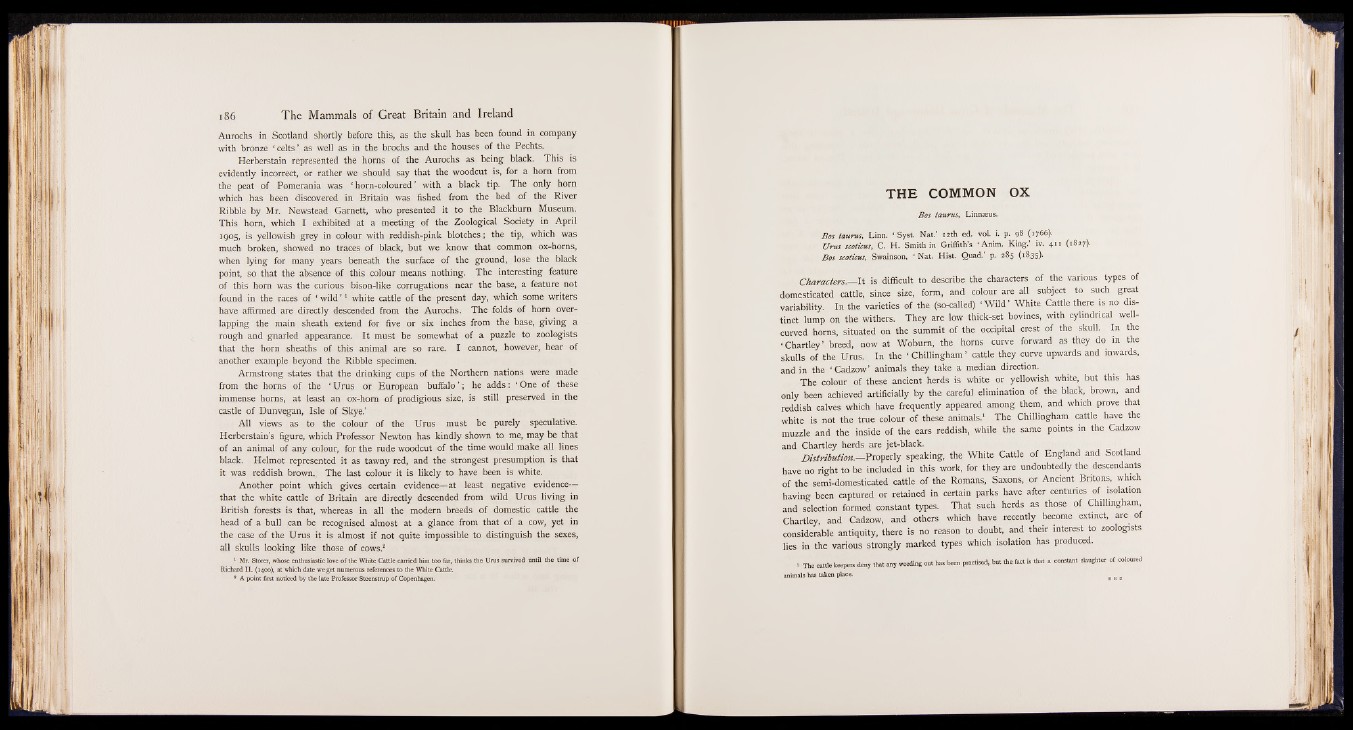
Aurochs in Scotland, shortly before this, as the skull has been found in company
with bronze ‘ celts’ as well as in the brochs and the houses of the Pechts.
Herberstain represented the horns of the Aurochs as being black. This is
evidently incorrect, or rather we should say that the woodcut is, for a horn from
the peat of Pomerania was * horn-coloured ’ with a black tip. The only horn
which has been discovered in Britain was fished from the bed of the River
Ribble by Mr. Newstead Garnett, who presented it to the Blackburn Museum.
This horn, which I exhibited at a meeting of the Zoological Society in April
1905, is yellowish grey in colour with reddish-pink blotches; the tip, which was
much broken, showed no traces of black, but we know that common ox-horns,
when lying for many years beneath the surface of the ground, lose the black
point, so that the absence of this colour means nothing. The interesting feature
of this horn was the curious bison-like corrugations near the base, a feature not
found in the races of ‘ wild ’ 1 white cattle of the present day, which some writers
have affirmed are directly descended from the Aurochs. The folds of horn overlapping
the main sheath extend for five or six inches from the base, giving a
rough and gnarled appearance. It must be somewhat of a puzzle to zoologists
that the horn sheaths of this animal are so rare. I cannot, however, hear of
another example beyond the Ribble specimen.
Armstrong states that the drinking cups of the Northern nations were made
from the horns of the ‘ Urus or European buffalo ’ ; he adds: ‘ One of these
immense horns, at least an ox-hom of prodigious size, is still preserved in the
castle of Dunvegan, Isle of Skye.’
All views as to the colour of the Urus must be purely speculative.
Herberstain’s figure, which Professor Newton has kindly shown to me, may be that
of an animal of any colour, for the rude woodcut of the time would make all lines
black. Helmot represented it as tawny red, and the strongest presumption is that
it was reddish brown., The last colour it is likely to have been is white.
Another point which gives certain evidence— at least negative evidence—
that the white cattle of Britain are directly descended from wild Urus living in
British forests is that, whereas in all the modern breeds of domestic cattle the
head of a bull can be recognised almost at a glance from that of a cow, yet in
the case of the Urus it is almost if not quite impossible to distinguish the sexes,
all skulls looking like those of cows.2
1 Mr. Storer, whose enthusiastic love o f the White Cattle carried him too far, thinks the Urus survived until the time of
Richard II. (1400), at which date we get numerous references to the White Cattle.
* A point first noticed by the late Professor Steenstrup of Copenhagen.
THE COMMON OX
Bos taurus, Linnaeus.
B os taurus, Linn. ■ Syst. Nat.’ 12th ed. vol. fr p. 98 (1766).
U rus sco ticu s,iS - H. Smith in Griffith’s 'A nim. King.' iv. 411 (1827)..
Bos scoticus, Swainson, ‘ Nat. Hist. Quad.’ p. 285 (1835).
Characters.— It is difficult to describe the characters of the various types of
domesticated cattle, since size, form, and colour are all subject to such great
variability. In the varieties of the (so-called) ‘ Wild ’ White Cattle there is no distinct
lump on the withers. They are low thick-set bovines, with cylindrical well-
curved horns, situated on the summit of the occipital crest of the skull. In the
‘ Chartley' breed, now at Woburn, the horns curve forward as they do in the
skulls of the Urus. In the • Chillingham ’ cattle they curve upwards and inwards,
and in the ‘ Cadzow’ animals they take a median direction.
The colour of these ancient herds is white or yellowish white, but, this has
only been achieved artificially by the careful elimination of the black; brown, and
reddish calves which have frequently appeared among them, and which prove that
white is not the true colour of these animals.1 The Chillingham cattle have the
muzzle and the inside of the ears reddish, while the same points in the Cadzow
and Chartley herds are jet-black.
Distribution.— Properly speaking, the White Cattle of England and Scotland
have no right to be included in this work, for they are undoubtedly the descendants
of the semi-domesticated cattle of the Romans, Saxons, or Ancient Britons, which
having been captured or retained in certain parks have after centuries of isolation
and selection formed constant types. That such herds as those of Chillingham,
Chartley, and Cadzow, and others which have recently become extinct, are of
considerable antiquity, there is no reason to doubt, and their interest to zoologists
lies in the various strongly marked types which|^olation has produced.
, The earn, keepers den, that any weeding out tars been practised, bn. the fact is that a constant slaughter of coloured
animals has taken place.